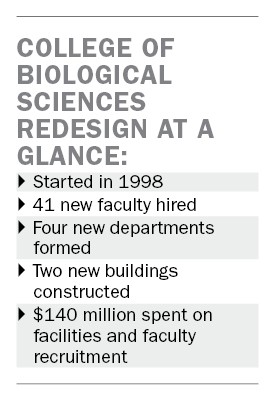A decade after a major effort to restructure the College of Biological Sciences was launched, college officials are calling it a success. The Molecular and Cellular Biology Initiative was launched in 1999 to help consolidate departments and make several improvements within the college. Robert Elde , dean of Biological Sciences, said the initiative aims to better department research, construct new facilities and recruit more than 40 new faculty members. Elde was chosen to lead the college in 1995 as CBS was in the middle of an evaluation process. Elde said it became his responsibility to guide the process and make sure the suggested changes were implemented. At the time, biological sciences at the University were spread across multiple colleges, he said, making it harder for researchers who shared similar disciplines to collaborate on work. For instance, CBS had a biochemistry department supporting about 15 faculty, while the Medical School had its own biochemistry department with about 20 faculty. âÄúThere wasnâÄôt as much synergy as you would expect for the total number of faculty in the discipline,âÄù he said. Administrators and faculty from the college proposed consolidating the departments to improve collaboration and unity. In 1997, the plan was incorporated into then-University President Mark Yudof âÄôs larger Molecular and Cellular Biology initiative. The initiative was approved by the Board of Regents in 1998, and $110 million was secured from the state to construct the Molecular and Cellular Biology building and hire faculty . Elde said the initiative got underway in 1999 with the introduction of four new, consolidated departments. The newly created departments were: Biochemistry, Molecular Biology and Biophysics ; Genetics, Cell Biology and Development ; and Plant Biology . A Neuroscience department was also created in the Medical School, but the undergraduates in the program are enrolled in CBS. New faculty started arriving in 2000, and over the next seven years 41 new professors were hired in CBS and the Medical School, he said. Prior to the initiative, neuroscience research at the University was spread among a number of different departments in the Medical School and other colleges, and there was no distinct department, Tim Ebner , head of the neuroscience department, said. Elde acknowledged that CBS was âÄúbehind the eight-ball in not offering undergraduate degrees in neuroscience,âÄù but Ebner said the consolidation and hiring of new faculty have helped the neuroscience attain a top-10 national ranking. âÄúThe degree of collaboration and interaction among a number of the faculty is really quite remarkable and wouldnâÄôt necessarily be there if they were spread out in a bunch of different departments,âÄù Ebner said. One of the neuroscience new hires in 2000, professor Paul Mermelstein , said the redesigned and expanded neuroscience department was âÄúvery appealingâÄù because the combination of senior faculty along with the addition of new faculty positioned the department on the cutting edge of research. Mermelstein said the neuroscience department did a good job of âÄúnurturing the young faculty and making sure they all become successful.âÄù Nine years after he was hired, Mermelstein is now a tenured professor and was awarded the McKnight Land-Grant Professorship . The consolidation of departments and hiring of new faculty has had a positive impact on all departments in CBS âÄî not just neuroscience âÄî Judson Sheridan , an ecology, evolution and behavior professor , said. Sheridan, who was associate dean for research in CBS at the time of the initiative, said the newer, bigger departments provide more opportunities for research, and the collaboration among faculty has led to a number of new centers on campus that could not have operated before the consolidation. Although there were some challenges in condensing administrative functions and integrating faculty who came from similar disciplines but different academic cultures, the departments are running much more efficiently than they were 10 years ago, he said. In addition to research benefits it has brought, the reorganization of CBS through the Molecular and Cellular Biology Initiative has also benefitted students, Elde said. During the reorganization, Elde said the students were always a consideration and a number of new programs and initiatives were introduced to help improve their experience. The biggest change, Elde said, was the decision for the college to begin admitting first-years. The school also introduced an innovative two-semester class aimed at giving first-year students a strong biological science foundation as well as introducing programs to help smooth the transition for incoming students into college life. âÄúWe wouldnâÄôt have been able to pull that off if we had not done the consolidation of the departments and didnâÄôt have the new facilities,âÄù he said, noting that CBS now has 5,500 applicants for only 400 spots.











